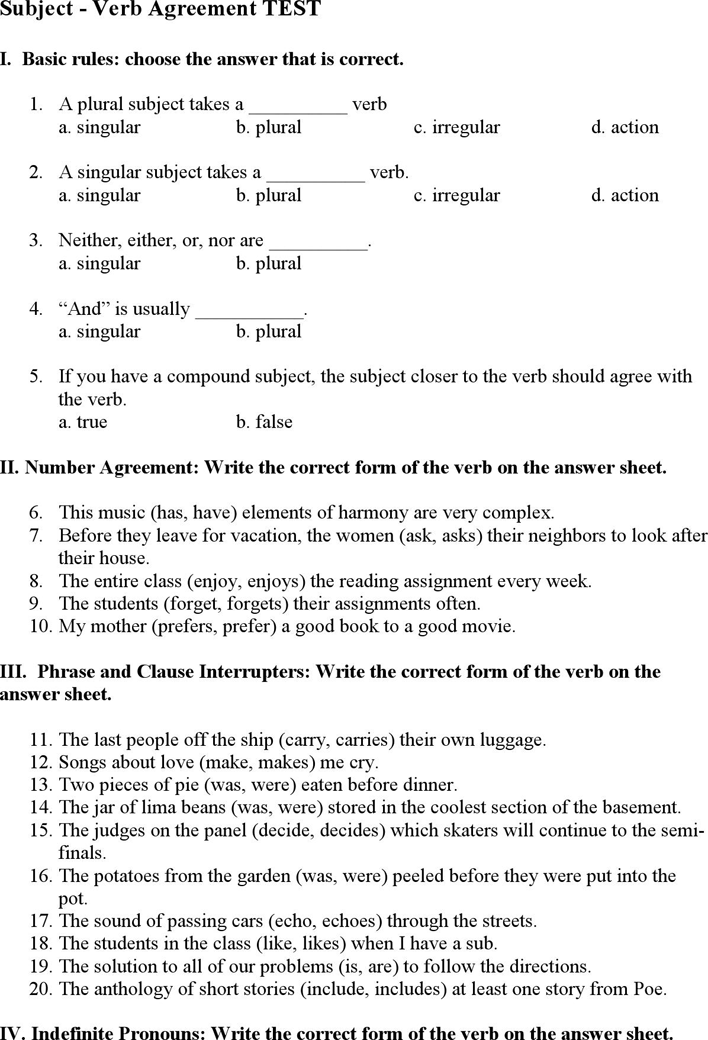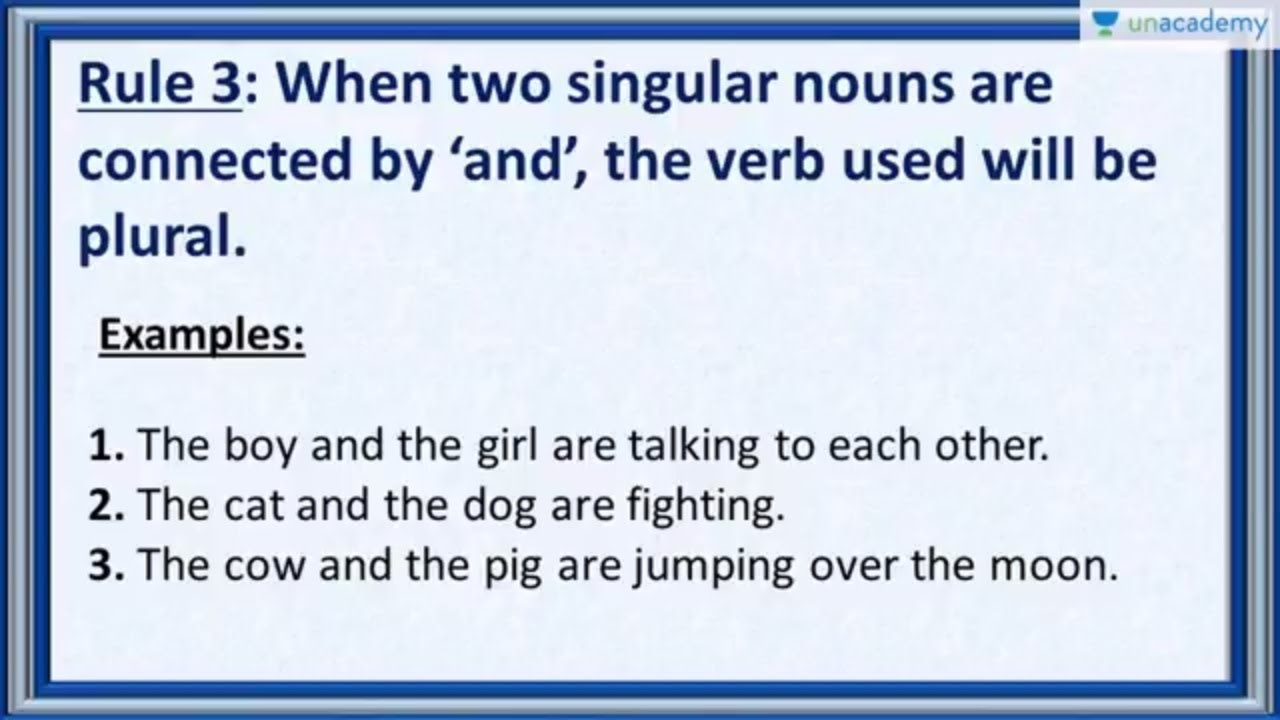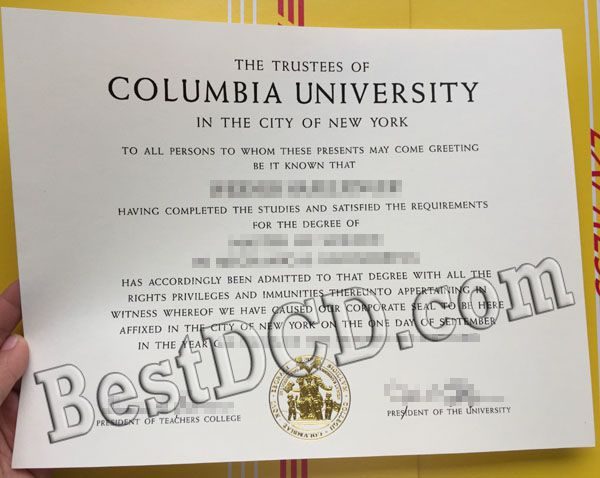When sentences start with "there" or "here," the subject is always placed behind the verb. It is important to ensure that each piece is properly identified. Subjects and verbs must match in numbers. It is the angle rule that forms the background of the concept.
All of the above sentences are continuously , and as you can see, the subject has no influence on the verb. The singular nouns in form like the rest, the rest and the number take plural forms in some contexts, but their number usually depends on the modifier. The agreement between themes and verbs is a must for each sentence.
For this sentence, the theme is "his little sister" and the verb is "play." 6. If two subjects are bound by "and," they generally need a plural form. Then the object of the preposition determines the form of the verb. Indefinite pronouns typically take singular verbs. The exceptions to the rule include the pronouns "few," "many," "several," and "both." These always take the plural form. Shouldn't Joe be followed by was, not were, given that Joe is singular?
But Joe isn't actually here, so we say were, not was. The sentence demonstrates the subjunctive mood, which is used to express a hypothetical, wishful, imaginary, or factually contradictory thought. The subjunctive mood pairs singular subjects with what we usually think of as plural verbs. If they are used in a singular sense, they take a singular verb and if they are used in the plural sense, they take a plural verb.
Subjects and verbs must agree in number. The subject must match the verb in person. The subject must match the verb in number. The subject must match the verb in gender. The subject must match the verb in tense. The subject must match the verb in voice.
The subject must match the verb in mood. The subject must match the verb in number and person. The subject must match the verb in number, person, and gender. The subject must match the verb in number, person, gender, and tense. The subject must match the verb in number, person, gender, tense, and voice.
The subject must match the verb in number, person, gender, tense, voice, and mood. A/An, many, few, number, and plural. Certain nouns exist in plural forms only. Thus 's' cannot be removed from such nouns to make then singular. They take the plural verbs with them. A singular subject takes a singular verb , whereas a plural subject takes a plural verb.
Doesn't is a contraction of does not and should be used only with a singular subject. Don't is a contraction of do not and should be used only with a plural subject. The exception to this rule appears in the case of the first person and second person pronouns I and you.
What Are The Rules Of Subject Verb Agreement With Examples With these pronouns, the contraction don't should be used. Subject verb agreement is the practice of matching a singular subject with a singular verb and a plural subject with a plural verb. However, many people are not familiar with the subject verb agreement rules, and frequently trip over these rules when writing.. Read more about subject-verb agreement exercises and let us know what you think.
If a collective noun is used in the sentence, and it is spoken of as a single/ united entity, a singular verb follows. BUT if individual members are being referred to, or the group is divided, in that case, a plural verb follows. With collective nouns such as group, jury, family, audience, population, the verb might be singular or plural, depending on the writer's intent. Some teachers, editors, and the SAT testing service, perhaps for convenience, have considered none to be strictly singular. However, authorities agree that none has been both singular and plural since Old English and still is.
If in context it seems like a singular to you, use a singular verb; if it seems like a plural, use a plural verb. When none is clearly intended to mean "not one," it is followed by a singular verb. With words that indicate portions—e.g., a lot, a majority, some, all—Rule 1 given earlier in this section is reversed, and we are guided by the noun after of. If the noun after of is singular, use a singular verb. If it is plural, use a plural verb.
Two singular subjects connected by or, either/or, or neither/nor require a singular verb. Nouns such as civics, mathematics, dollars, measles, and news require singular verbs. When two or more singular nouns or pronouns are connected by or or nor, use a singular verb. When the subject of a sentence is composed of two or more nouns or pronouns connected by and, use a plural verb. Deer, sheep, series, species, fish, crew, team, jury, plane, lawyer are certain nouns used in both the singular and plural.
If they are used in the singular, take a singular verb, and if they are used in the plural, take a plural verb. "Neither" and "either" require singular verbs even though they seem to be referring to two separate things. "Anyone," "everyone," "someone," "no one," and "nobody" always require singular verbs. You can also download our shorter top 10 rules infographic and keep it handy. To see more sentences showing the correct subject and verb agreement, check out examples of subject-verb agreement. A collective noun, such as "team" or "staff," can be either singular or plural depending upon the rest of the sentence.
Typically, they take the singular form, as the collective noun is treated as a cohesive single unit. Such nouns have no plural form but sometimes we need the singular/plural form of some of these nouns. The singular/plural form is made by adding certain words before the uncountable nouns. If there is a division among the members of the collective noun or we talk about the members of the collective noun, plural verb and plural pronoun are used. Sometimes the subject is separated from the verb by such words as along with, as well as, besides, not, etc.
These words and phrases are not part of the subject. Ignore them and use a singular verb when the subject is singular. Some nouns exist only in the plural. Therefore, the s cannot be removed from these names to make them singular. These nouns have no plural form, but sometimes we need the singular/ plural form of some of these nouns.
The plural form is formed by putting certain words in front of non-countable nouns. If two subjects are joined by "and," they typically require a plural verb form. The same system of the subject-verb agreement also applies to indefinite pronouns such as all, enough, and some. An optative Sentences, singular subject takes plural verb. We need to be familiar with singular and plural verbs.
When talking about an amount of money, it requires a singular verb, but when referring to the dollars themselves, a plural verb is required. When each is used after a plural noun or plural pronoun, a plural verb is used. When two non-countable nouns are put together and are about different subjects, a plural verb is used. In a sentence, the subject of a sentence follows the verb, and the verb of a sentence always follows the subject.
This is the most important rule in English grammar. But there are some exceptions, such as when a subject-verb agreement is not required in a subject-verb agreement. They are us… You should not submit to us all your business.
We should not be told by you all you need to know. You ought not to do to me all you can. He ought to be punished for his crime. She ought to be punished for her crime.
The verb must agree with the Subject when the Subject is the combination of two or more nouns or pronouns joined by 'and'. Modifiers between the subject and verb do not affect whether the verb is singular or plural. When gerunds are used as the subject of a sentence, they take the singular form of the verb.
However, when they are linked by "and," they take the plural form. It might seem like subject-verb agreement has many rules, but you'll quickly notice that one ties into the next. In the end, it'll all make sense.
To help clarify the examples of each rule, the subjects are in bold and verbs are in italics. If you are interested in subject-verb agreement, you've come to the right place. However, before diving headfirst into the rules, it's good to have a little explanation. The subject and verb within a sentence need to agree with each other in number in order for a sentence to make sense. You might think that subject-verb agreement would be pretty simple. However, it can get quite tricky depending on the complexity of the sentence.
Learn the subject-verb agreement rules through several examples. Use a colorful printable to help them stick in your mind. If an article is placed just before the 1st subject, it means the person/think is the same for which two nouns are used. Hence singular verb will be used. An indefinite pronoun is always followed by a singular verb.
When the subject and verb are separated by a long phrase or a clause, the verb must agree with the actual subject (and not that of the phrase/ clause). Do not be misled by a phrase that comes between the subject and the verb. The verb agrees with the subject, not with a noun or pronoun in the phrase. When of is used after each, every, one, etc. A noun or pronoun that immediately follows or is used in the plural.
What happens in the second part of the sentence is singular. When there is a separation between the members of a collective noun or when we talk about the members of a collective noun, we use a verb and a plural pronoun. When two or more nouns or adjectives are joined, but only one person, thing or idea is involved, a singular verb is used.
To approach the rules of subject-verb agreement, you must first know the basic difference between a verb and a noun. Subject-verb agreement is generally quite straightforward in English. Check any handbook for the general rules. However, with subjects that introduce the idea of quantity, some additional rules of thumb are needed. Here are a few that are useful for academic writing.
The words 'many, neither, many a, each, everyone, every etc..' require only singular verbs. With money, if the amount is specific, use a singular verb; if the amount is vague, use a plural verb. Collecting noun phrases (a bunch of, a group of, a set of, etc.) take a singular verb. A subject made up of nouns joined by and takes a plural subject, unless that subject's intended sense is singular.
This is the cornerstone rule that forms the background of the concept. And, only the subject affects the verb! From the sentence, a singular subject is only grammatically correct when its corresponding verb is in the singular, as well.
In other words, both the verb and its subject must be in either singular or in the plural as dictated by a set of rules, unless otherwise. With uncountable nouns we use 'Amount of /Quantity of' followed by a singular verb. Here, 'students' and 'teacher' are the two nouns. The verb should agree with the first noun, which is 'students'. The underlying rule is that the subject and verb must agree with each other in number.
Use a singular verb with distances, periods of time, sums of money, etc., when considered as a unit. As a general rule, use a plural verb with two or more subjects when they are connected by and. The verb in an or, either/or, or neither/nor sentence agrees with the noun or pronoun closest to it. For non-countable nouns, we use Quantity of /Quantities or followed by a singular verb.


















































